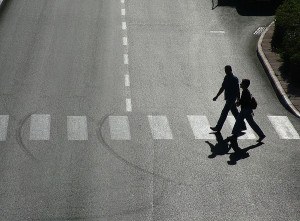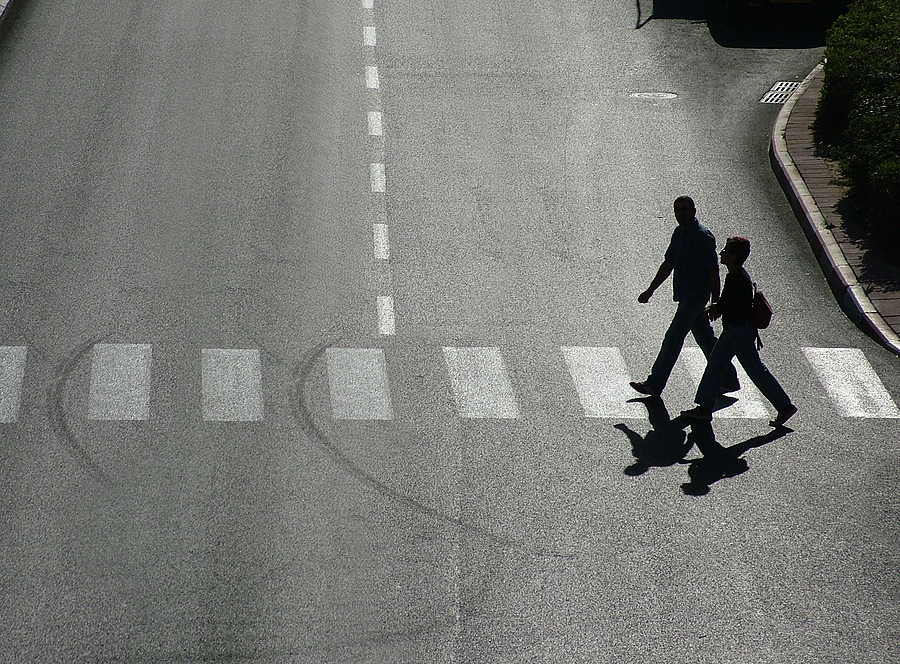Twice in a week this month in unrelated collisions, cars barreled into pedestrians on East Colfax Avenue, in Aurora, killing one man and seriously hurting another.
And investigators say those two crashes are far from outliers. They’re part of a disturbing spike in auto vs. pedestrian crashes, particularly fatal ones, across Colorado.
In one of the crashes, a vehicle police think was a white Cadillac Escalade hit a man near Colfax and Clinton Street June 11. The pedestrian later died at a local hospital and police are still searching for the driver who fled the scene.
Six days later, a man crossing the street near Colfax and Peoria Street was hit by a car. That man was seriously injured in the crash but police said he is expected to survive. Surveillance cameras at a nearby business caught footage of the vehicle, which also fled the scene, and later in the week police were able to find the vehicle and the driver. Charges in that case are still pending.
 In all, fatal auto vs. pedestrian crashes have nearly doubled statewide during the past decade. In response, local police and state transportation officials have launched campaigns aimed not just at drivers who are often at fault in these crashes, but also pedestrians, who police say sometimes are as distracted as the worst distracted drivers.
In all, fatal auto vs. pedestrian crashes have nearly doubled statewide during the past decade. In response, local police and state transportation officials have launched campaigns aimed not just at drivers who are often at fault in these crashes, but also pedestrians, who police say sometimes are as distracted as the worst distracted drivers.
Last week local police officers hit Aurora streets toting flyers detailing the risks of auto pedestrian crashes. The goal, Aurora police spokesman Officer Kenneth Forrest said, is to get the message through to pedestrians that they are putting themselves at serious risk if they don’t obey traffic laws.
Officers can write tickets for jaywalking, but Forrest said that is rarely the route they prefer to go. Instead, he said the flyers and a conversation about basic traffic safety can go a long way.
“The big thing is to get the information out there,” he said.
Police try to focus that messaging on the stretches of road where cars and people are most likely to come into dangerous contact. One of those areas is near the Anschutz Medical Campus, where cars zooming past on Colfax and Peoria motor near thousands of workers, students and patients everyday.
“The Colfax corridor is always busy, just a dense population and a lot of cars,” he said. “We do have a lot of auto-peds in that area.”
While Colfax had a couple of the most-recent auto vs. pedestrian crashes in Aurora, it’s hardly alone.
East Sixth Avenue near Del Mar Park is a tough spot, Forrest said.
Last month, a 17-year-old girl was killed at Sixth and Peoria, just north of the park, when she was struck by a car. Police later said that driver stayed at the scene and won’t face charges because it appears the young girl caused the crash by darting into oncoming traffic.
South Havana Street is always a problem area, Forrest said, because the speed limits there are higher than they are on other streets, so the risk of death or serious injury is greater.
One of the messages police are trying to drive home, Forrest said, is that a car doesn’t have to be hurtling at highway speeds to kill a pedestrian. If a vehicle is going 40 mph, a common speed on metro streets, and it hits a pedestrian, Forrest said data shows the pedestrian dies 90 percent of the time.
And just as society’s attachment to their phones can lead to more distracted drivers, Forrest said those devices can be risky for pedestrians, too.
Distracted pedestrians are nothing new, he said, and police have long worried about people trying to walk near busy streets while eating or doing something else that takes their focus off of cars rolling by.
Phones just added another newer distraction.
“They are still eating now, but they have their cell phone, they have their GPS,” he said.
Back in 2010, 40 pedestrians were killed on Colorado’s roads, according to the Colorado Department of Transportation.
That number actually marked a decline from the prior few years, which saw 51 fatalities in 2009 and 47 in 2008.
But the numbers have since ballooned to more than 90 last year, according to CDOT.
So far in 2018, there have been at least 30 fatalities on Colorado’s roads.
Auto vs. pedestrian crashes make up a small fraction of the overall number of fatalities on Colorado’s roads. Last year, there were 648 fatalities on Colorado’s roads and just half of those killed – 320 – were drivers.
Still, while the total of all road fatalities was up from the year prior, it was up just 6 percent, from 640 to 648, and up 44 percent from 2010.
Auto vs. pedestrian fatalities are up 130 percent from 2010, and that’s a particularly troubling trend for state transportation officials.
“Pedestrian fatalities, sadly, in this state are spiking, even more than the state average for fatalities overall,” said Sam Cole, a spokesman for CDOT.
Figuring out exactly why these particular fatal crashes have spiked is tricky, Cole said.
Certainly, the state’s population growth plays a role in it, he said. More people calling Colorado home means more cars on the road and more pedestrians.
Traffic congestion is also likely a factor because it might mean more people are opting to walk rather than sitting in traffic.
The biggest issue, though, Cole said, is the same thing at the root of many traffic safety matters: distraction.
“It does boil down to human behavior though, both on the part of drivers and pedestrians,” he said.
That means drivers looking down at their phones and not seeing pedestrians in crosswalks, but also pedestrians not paying attention traffic signals, he said.
Distracted drivers get more attention in the traffic safety discussion, but Cole said there are simple steps pedestrians can take to help ensure they don’t get hit, mainly by paying attention and avoiding crossing streets mid block – jaywalking.
“We’re not victim-blaming you, we are simply trying to keep you safe,” he said. “Until there are perfect drivers out there, you need to be careful.”
In recent years, CDOT has used a campaign built around a fictional character named “Fred Estrian” to bang the drum about pedestrian safety. This spring they brought the character back with videos and flyers warning pedestrians about the risks on the road.
Cole said he thinks the bulk of pedestrians get the message about the risks of getting by a speeding car that weighs thousands of pounds. The tough hurdle to get over is the false sense of security so many people have.
“Most people do understand that, they just have a false sense of security and think they will be seen, and you never want to take that chance,” he said.
CDOT has also enlisted the help of some of the people most-directly effected by auto vs. pedestrian crashes to help get their message out.
One of those is Robye Nothnagel.
A driver in Texas ran into the Eagle woman last year while she was visiting there, leaving her with a fractured pelvis and a shattered leg.
The car was going about 40 mph when the driver smashed into Nothnagel, sending her flying onto the hood and then the windshield.
“The girl was looking down at her phone,” Nothnagel said.
The driver later told police she didn’t even see Nothnagel until she came up in the windshield. That meant she was so distracted, she never saw Nothnagel, nor the other five people she was with walking down the street. She also didn’t notice the woman on her hood until a split second later when that woman slammed into the windshield.
“First time I read (the police report), it made me almost throw up,” she said.
Today, Nothnagel hopes to make sure no other pedestrian goes through what she went through.
She said she has fully eliminated her own cell phone use while walking or driving and now speaks to young people and business groups about the dangers of distracted driving.
Her crash left her in the hospital for weeks and unable to walk for months. Still, she is well aware of the statistics for pedestrians hit by cars going as fast as the one that smashed into her.
“I realize I am lucky and grateful for being here,” she said.
Among the other advocates she has met, she said she is the rare cases.
“Most people who advocate in regards to distracted driving are doing it because they lost a loved one,” she said.
Beyond getting people to put their phones down, she said she wants to see the laws changed so the public has a better idea of just how pervasive distracted-driving-caused crashes are. Police reports need a simple box that crash investigators can check saying a crash was the result of a distracted driver, she said.
In her case in Texas, and in others in Colorado, police don’t have that option.
“My crash was not a statistic in distracted driving,” she said.
The box in her case just said “other.”
Nothnagel said she also wants to get the message out that it isn’t just teenagers or young people who are hooked on their phones and can’t seem to look away.
The teens she speaks to actually seem to grasp the risk of distracted driving, she said.
It’s the adults in their lives who don’t have such a keen grasp on the risks.
“It’s really the parents that are sending the message to the kids,” she said. “They are modeling their behavior. The parents need to be more aware of it, too.”
Was this article valuable?
Here are more articles you may enjoy.


 Google Faces UK Class Action From Businesses Over Online Search Dominance
Google Faces UK Class Action From Businesses Over Online Search Dominance  In Fight Over Insurance, Neighbors Crowdsource LA Fire Contamination Data
In Fight Over Insurance, Neighbors Crowdsource LA Fire Contamination Data  Inspections of Affected Barrels Will Take Time as Flood Cleanup Progresses at Kentucky Distillery
Inspections of Affected Barrels Will Take Time as Flood Cleanup Progresses at Kentucky Distillery  Survey Shows Distracted Drivers Overconfident: 20% Text While Driving, 15% Use Social Media
Survey Shows Distracted Drivers Overconfident: 20% Text While Driving, 15% Use Social Media 